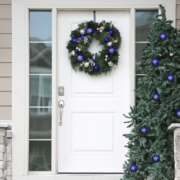Top Tips for Outside Door Frame Replacement: DIY Guide
Wondering how to handle outside door frame replacement? This guide explains signs of a failing door frame, the tools and materials you’ll need, and provides step-by-step instructions for the replacement process.
Key Takeaways
-
Recognizing signs of damage, such as wood rot and misalignment, is crucial for determining when to replace an outside door frame.
-
A successful DIY door frame replacement requires specific tools and materials, including a door frame kit, nails, and shims, along with careful measurement and assembly.
-
Regular maintenance of exterior door frames, including checks for rot and caulk integrity, is essential for prolonging their lifespan and ensuring functionality.
Recognizing When to Replace Your Outside Door Frame

A worn-out outside door frame indicating the need for replacement.
Recognizing the right time to replace your outside door frame is key to maintaining your home’s security and aesthetics. A sagging door or stripped screws can signal that the frame no longer supports the door adequately. Visible damage like cracks or dents also indicates that the door frame requires attention, as these issues compromise both functionality and security.
Wood rot is another compelling reason for door frame replacement. This damage often necessitates a full frame replacement to maintain structural integrity. Prolonged exposure to moisture can lead to rot, weakening the wood and its ability to support the door. Additionally, replacing the frame is necessary if installing a new door of a different size or if the existing frame is beyond repair.
Identifying these signs early can prevent more extensive and costly repairs. Addressing rotted wood, visible damage, and misalignment promptly helps maintain your home’s safety and appearance.
Gathering the right tools and materials is essential for a successful DIY door frame replacement.
Tools and Materials Needed for Outside Door Frame Replacement
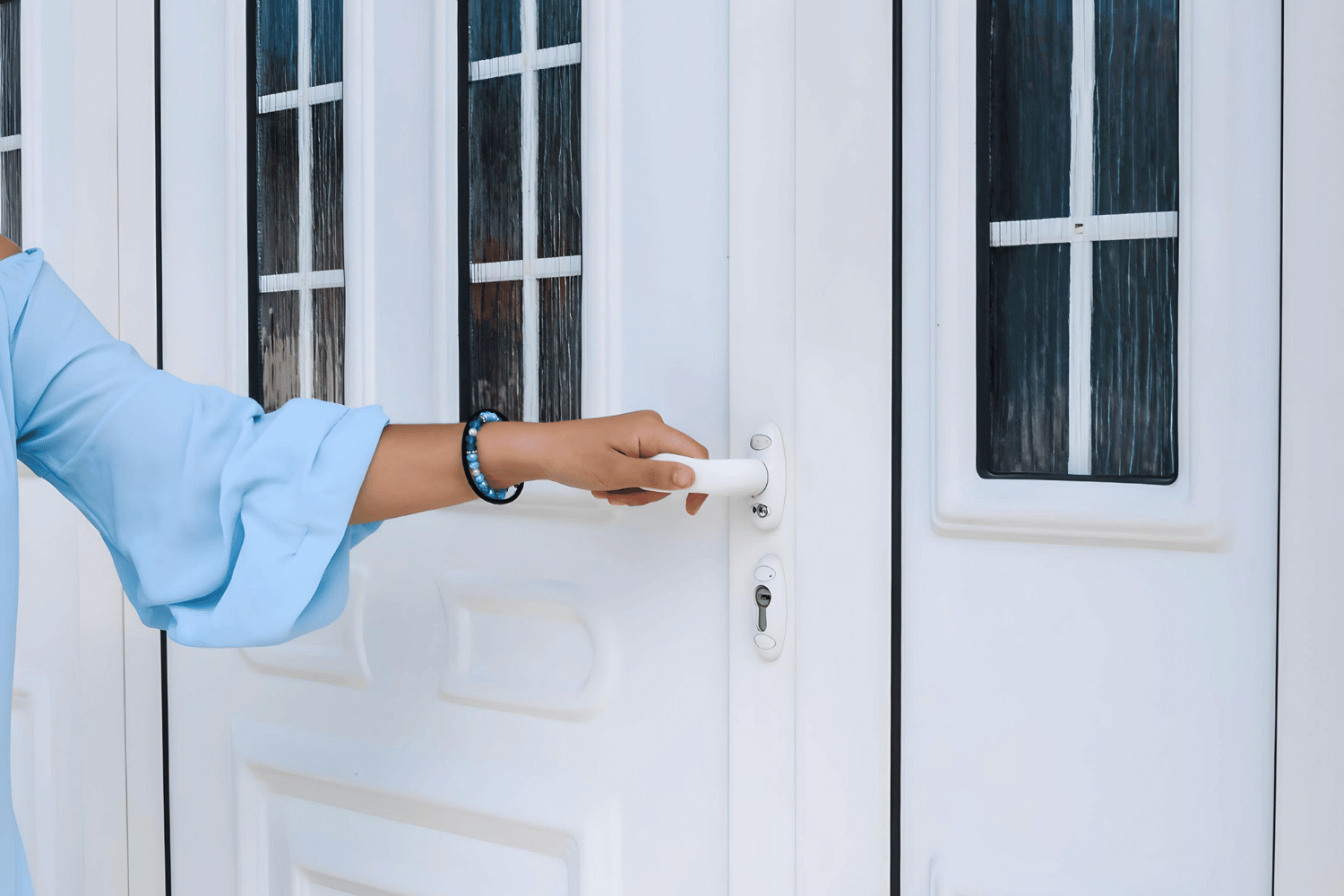
Tools and materials needed for outside door frame replacement.
A DIY door frame replacement requires specific tools and materials for a successful job. Essential tools include a pry bar, hammer, utility knife, chisel, handsaw, flat edge pry bar, and utility square. These tools aid in carefully removing the old frame and preparing the area for the new installation, ensuring the process is smooth and minimizes damage to the surrounding structure.
Before:
Besides tools, several materials are required for the replacement. A door frame kit, which usually includes two side jambs, a head jamb, and weatherstripping, is essential. Additionally, you will need nails, shims, screws, and foam insulation.
After:
Several materials are required for the replacement:
-
A door frame kit, which usually includes two side jambs, a head jamb, and weatherstripping
-
Nails
-
Shims
-
Screws
-
Foam insulation
Optional items like trim or a prehung door can enhance the final look and simplify installation. With these tools and materials, you are well-prepared to proceed with the door frame replacement project.
Step-by-Step Guide to Removing the Old Door Frame
Removing the old door frame is crucial for a successful replacement. Follow these steps to ensure a clean and effective removal, setting the stage for new frame installation.
Preparing the Area
Before removing the existing door and frame, ensure they are level and plumb for accurate measurements of the new frame. Measure the current door frame’s dimensions carefully to ensure a perfect fit. Wear safety goggles to protect your eyes from debris during the removal process.
Start by using a screwdriver or power drill to unscrew the hinges from the door jamb. After removing the door, focus on the frame. Clear the rough opening of debris and clean it thoroughly to provide a solid foundation for the new frame, preventing alignment or installation issues.
Removing the Existing Door Frame
Make a horizontal cut through the middle of each door jamb to facilitate removal. Use a utility knife to run beneath the edges of the trim, loosening it before removal. Set aside removed shims for potential reuse. Use a pry bar to effectively loosen and remove the door jambs.
A flat edge pry bar helps remove the old frame and trim without damaging surrounding walls. A chisel and hammer are useful for loosening the trim after using the utility knife. Cut through the old door jambs at a 45-degree angle for easier removal. Be cautious to avoid damaging the entire wall during frame removal.
After removing the frame, inspect the rough opening for damage or moisture issues. Addressing these problems beforehand ensures a long-lasting and secure fit for the new frame.
Installing the New Door Frame
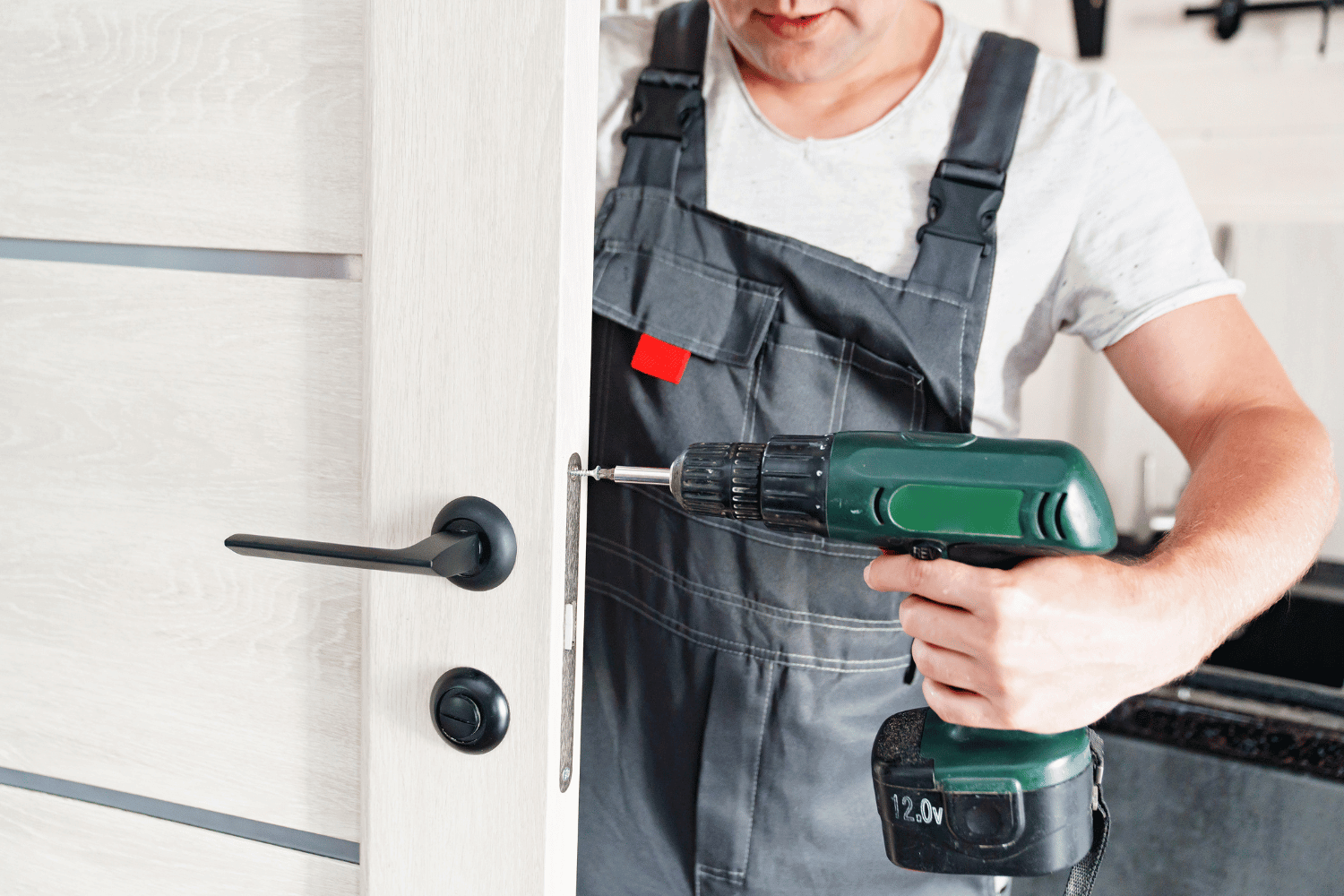
Installing a new door frame in an exterior setting.
Several critical steps are involved in installing a new door frame to ensure it is secure and functions smoothly.
This section will guide you through measuring, cutting, assembling, and securing the new frame.
Measuring and Cutting the New Frame
Accurate measurement of the rough opening is crucial for a perfect fit. Measure at the top, middle, and bottom, using the largest measurement. Also, measure the dimensions of the existing door frame before removal. Use a level to ensure measurements are consistent and precise.
Mark the correct dimensions on the timber and cut straight using a hand saw. Accurate measurements and cuts ensure that the new frame fits snugly into the rough opening, preventing alignment issues and achieving a professional finish.
Assembling and Positioning the Frame
Assembling the frame on the floor before positioning it in the opening helps ensure proper alignment. Securely attach the head jamb to the top of the side jambs during assembly. Use a spirit level to check that the frame is positioned correctly and leveled.
If the frame is not plumb, insert shims between the wall and the jambs to adjust. Score the shims with a utility knife to make them flush with the wall. Careful assembly and positioning ensure a secure and properly aligned door frame.
Securing the Frame
Securing the door frame is vital for stability and functionality. Start by driving nails into marked points on the frame, beginning from the hinge side. Screws can provide a stronger hold than nails.
Check the corners with a utility square to ensure the frame is squared correctly for proper door operation. Use wooden shims to adjust the frame if it is out of alignment. These steps ensure the door operates smoothly and securely once installed.
Insulating and Sealing the Door Frame
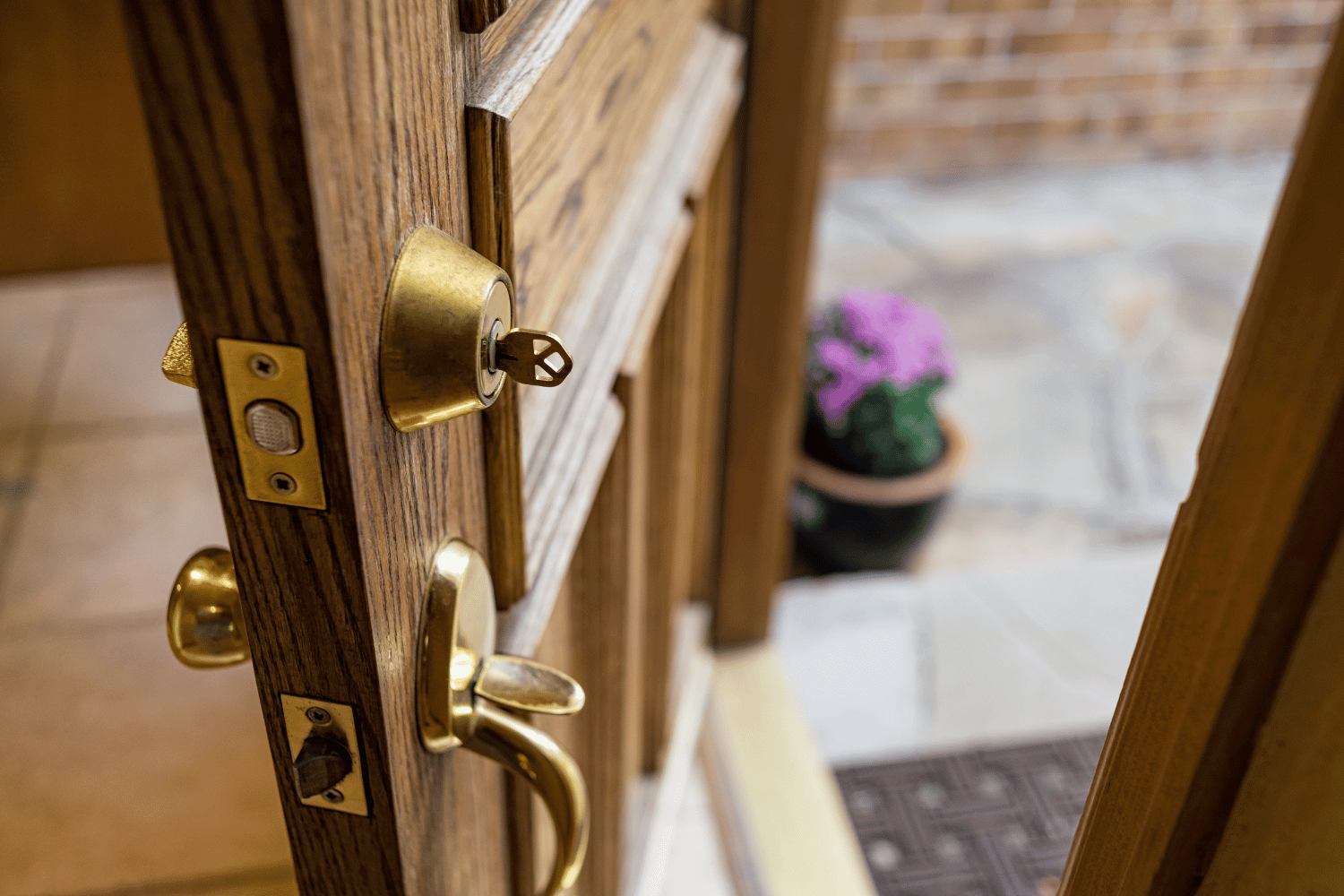
Insulating and sealing an exterior door frame.
Insulating and sealing the door frame prevents air leaks and increases energy efficiency. Foam insulation strips effectively fill gaps around door frames, enhancing energy efficiency.
Apply caulk to seal small gaps and cracks around the door frame, preventing moisture entry and enhancing insulation. For maximum energy efficiency, use weather stripping and caulk together. These steps keep your home comfortable and reduce heating and cooling expenses.
Reinstalling the Door
With the new frame securely in place, reinstall the door. Gently set the door in the frame and align the hinges. Ensure the hinge placements match and adjust the door as needed.
Install the strike plate to ensure the door latches correctly. Finally, test the door’s swing to confirm it opens and closes smoothly. These steps ensure your door operates as intended, providing the necessary security and functionality.
Finishing Touches
Finishing touches significantly impact the overall appearance of your door frame. If the old trim is unsuitable for reuse, obtain new trim that matches the aesthetic of the newly installed frame.
Apply caulk around the edges of the trim after reinstalling it to create a smooth finish. Use wood putty to fill any gaps left from repositioned hinges or strike plates for a neat appearance. Once the caulk dries, the door frame will be ready for use.
DIY vs. Hiring a Professional
Replacing a door frame is a manageable task for homeowners with the right tools and assistance. The cost difference between DIY and hiring a professional can be significant, making DIY appealing for budget-conscious homeowners.
However, for those lacking the time or confidence to complete the project, hiring a professional can be the best option. Professionals bring expertise and efficiency, ensuring the job is done correctly and quickly. Ultimately, the choice depends on your skill level, budget, and comfort with the project.
Maintenance Tips for Exterior Door Frames
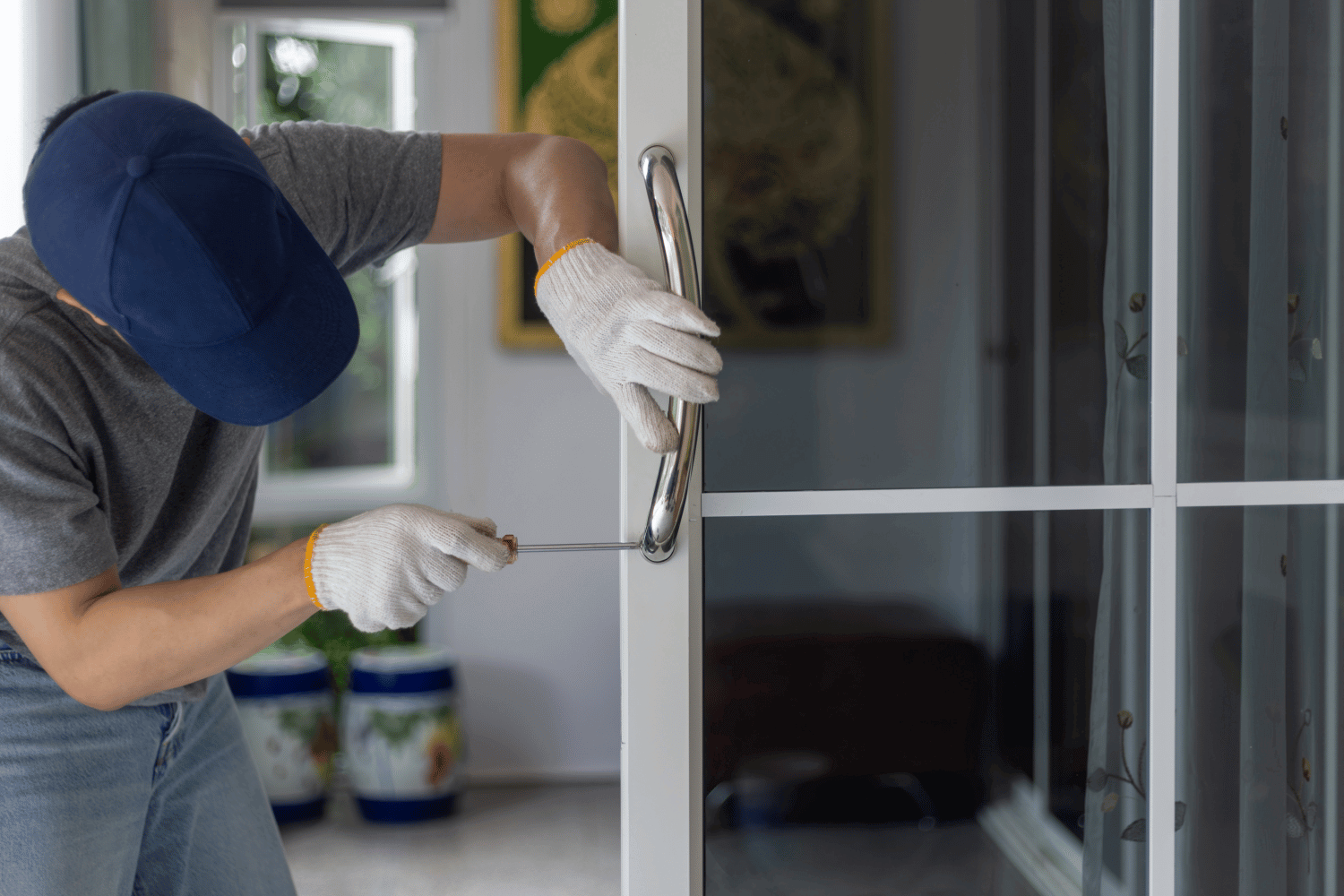
Maintenance tips for exterior door frames, focusing on upkeep.
Regular maintenance of your exterior door frame can prevent issues like rot and damage. Look for signs of rot, such as peeling paint, cracks, and dark patches indicating fungi growth. Functional issues like jamming when opening or closing may suggest rot development in the frame.
Regularly check the caulk and replace it if it shows signs of cracking or peeling, ideally using a flexible silicone-based product. Inspect hardware like screws and tighten or replace them if worn or rusted, with galvanized screws recommended for exterior use.
These maintenance tips help extend the life of your door frame and ensure it remains in good condition.
Summary
Replacing an exterior door frame can seem like a daunting task, but with the right tools, materials, and guidance, it becomes a manageable and rewarding DIY project. Recognizing when to replace your door frame, gathering the necessary tools and materials, and following a step-by-step guide ensures a successful outcome. Whether you choose to do it yourself or hire a professional, maintaining your door frame through regular inspections and repairs will keep it in top shape.
By following the steps outlined in this guide, you can enhance the security, energy efficiency, and aesthetic appeal of your home. Take pride in your home improvement skills and enjoy the benefits of a well-installed door frame.
Frequently Asked Questions
What are the signs that my door frame needs replacing?
If your door frame shows signs of sagging doors, stripped screws, visible damage, wood rot, or if you need to install a differently sized door, it likely needs replacing. Addressing these issues promptly can prevent further damage and ensure proper function.
What tools and materials are needed for a DIY door frame replacement?
For a successful DIY door frame replacement, you will need tools such as a pry bar, hammer, utility knife, chisel, handsaw, flat edge pry bar, and utility square. Additionally, gather materials including a door frame kit, nails, shims, screws, and foam insulation.
How do I ensure the new door frame fits properly?
To ensure the new door frame fits properly, measure the rough opening at the top, middle, and bottom, taking the largest measurement for accuracy. Use a level to check the consistency of your measurements. This approach will help guarantee a proper fit.
What are the benefits of insulating and sealing the door frame?
Insulating and sealing the door frame effectively prevents air leaks, resulting in reduced heating and cooling costs. Utilizing foam insulation strips and caulk significantly improves energy efficiency.
Should I attempt a DIY door frame replacement or hire a professional?
If you possess the necessary tools and skills, a DIY door frame replacement can be a cost-effective solution. However, hiring a professional ensures the work is completed correctly and efficiently, which may be preferable for many homeowners.
About The Author
Elias Abadi
Owner
Elias, the founder of CoMo Premium Exteriors, has steered the company to become a leading exterior renovation firm in Mid-Missouri, emphasizing quality and customer-centric values. A Columbia resident since age 10, he is an ardent Mizzou athletics supporter. Outside of work, Elias enjoys family time, attending his three sons’ sports activities, and engaging in outdoor pursuits like hiking, fishing, gardening, and hunting.





